AGNIESZKA PILCHOWA TIMELINE
1888 (December 16): Agnieszka Wysocka was born in Zarubek, a town near Ostrava (today in Czech Republic).
1906 or 1907: Wysocka contacted a Czech Spiritualist in Radvanice near Ostrava and participated in séances.
1911: Wysocka was raped by Józef Kurletto and, as a result of social pressure, married her assailant.
1914: Wysocka allegedly received teachings from the astral world, thus attaining the ability to diagnose and heal diseases.
1915: Wysocka left her first husband and took their two children, Stanisław and Anita (later known as Anna), with her.
1917: Wysocka obtained legal annulment of her marriage to her first husband for reasons that included violence and rape.
1919–1920: Wysocka moved to Poland, finally settling in the town of Wisła in Cieszyn Silesia, Poland. She was already a renowned healer, so immediately she became a participant in a local esoteric circle, writing her manuscripts, and possibly taking part in séances.
1921 (June 6): Janina Wysocka, daughter of Agnieszka and Jan Pilch was born. Later, after her parents’ marriage, her name was changed to Pilch as well (Pilchówna being a form of the surname of daughter).
1922: Wysocka published two books: Kilka obrazków chorób umysłowych. Ich istota, przyczyny i sposoby leczenie zaczerpnięte droga jasnowidzenia z Rzeszy Ducha i własnego przeżycia [A Few Pictures of Mental Diseases: Their Essence, Causes, and Methods of Treatment, Learned through Clairvoyance from the Realm of the Spirit and Own Experience] and W niewoli żydowskiej czyli wolno w Polsce jak kto chce! Słowo Prawdy do Narodu [In Jewish Slavery or in Poland One Does as One Wants! Words of Truth to the Nation].
1923: Agnieszka married Jan Pilch taking his surname (“Pilchowa” being a female form of “Pilch”), but the exact date is unknown. She started to use the new name in selected publications beginning in 1923. Thereafter she used the names Wysocka, Pilchowa, initials, and “Agni P.” interchangeably in her publications (also a mix of all of the above). Agni was a kind of a nickname; it is both an abbreviation of the name Agnieszka, but also a reference to the Hindu god of fire, Agni, understood as a kind of force, or principle of the universe. Agni was very popular among esotericists at the time, for example in the Agni Yoga movement.
1926: Pilchowa published, as Agnieszka Wysocka, the book Życie na ziemi i w zaświecie czyli wędrówka dusz [Life on Earth and in the Other World or Wandering Souls].
1930: Pilchowa published her magnum opus, a biographical book titled Pamiętniki Jasnowidzącej z wędrówki życiowej poprzez wieki [The Clairvoyant Memoirs: The Journey of Life Through the Ages], without her name on it. The full title includes Preceded by an introduction about the essence of clairvoyance, a new era, etc. And supplemented with an appendix in which i.e. a number of examples of manifestation of the law of karma and reincarnation in the lives of well-known people are cited. But she was introduced by publishers in a note “From Publisher” as Agni. The book was very popular in Poland, and gained Pilchowa a group of followers who came to Wisła to meet her and ask for healing (spiritual and with herbal medicine) and for her visions of the future.
1932: Pilchowa published the occult novel Zmora [Nightmare] as A. P. The novel was popular throughout the country.
1933: Pilchowa published the book Spojrzenie w przyszłość [A Look into the Future] and the second part of above-mentioned Zmora, titled Umarli mówią [The Dead Speak] as “Agnieszka Wysocka (A. P.).”
1934: Jan Hadyna, who was a part of the same esoteric circle in Wisła, made Agnieszka and Jan Pilch the editors of one of the most popular occult magazines in Poland at the time, Hejnał: Miesięcznik wiedzy duchowej [The Bugle Call: Spiritual Knowledge Monthly].
1935: Pilchowa published the book Jasnowidzenie [The Clairvoyance].
1943: The Pilch couple and their daughter Janina were arrested by the Gestapo (Nazi Secret State Police).
1944: Pilchowa was sent to the Ravensbrück concentration camp for women in Germany.
1945 (January 4): Agnieszka Pilchowa was probably shot during one of the final executions of prisoners in the Ravensbrück camp.
BIOGRAPHY
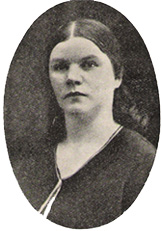
Agnieszka Wysocka was born on December 16, 1888 in Zarubek, near the Czech town of Ostrava. [Image at right] Despite being born in Czech territory she came from a Polish family. Wysocka claimed that she was born with clairvoyant abilities and, as a child, shunned her peers and felt alienated. Already as a girl, she allegedly had visions of unknown places, people, and events. She told her siblings about them, but was laughed at. As a result, she hid her abilities and avoided her peers so as not to expose herself to mockery (Pamiętniki Jasnowidzącej 1930). A breakthrough moment in her life was a three-day comatose state she fell into as a girl after a visit to a nearby monastery where something shocked her. Wysocka later claimed that during the experience she traveled across the astral world, where she met a luminous being who became her spiritual guide and guardian. She later claimed that this spiritual being accompanied her constantly. The guardian took Agnieszka on a journey around the globe, talked about the astral world, and showed her scenes from the life of Christ. The contact with the guardian, called Mirjam, was to last for many years, through automatic writing (Pamiętniki Jasnowidzącej 1930). Wysocka would sign some of her works “Mirjam,” thus indicating that she used that name only when relaying a message received from her guardian (Dulska and Hess 2019).
As a teenager, Wysocka sought the company of people similar to her. In Radvanice near Ostrava she began to attend Spiritualist séances. According to her memoirs, she first became a medium at the age of eighteen. However, she quickly gave up her participation in séances, following accusations of attending them to find a husband. According to Wysocka, these accusations were “hideous slanders” spread under the influence of evil spirits trying to impede her activities (Pamiętniki Jasnowidzącej 1930).
Disappointed by the attitude of Spiritualists toward her, Wysocka resigned from her spiritual quests, and she pursued an active social life. But in 1911 she was raped by her brother’s friend during one of the parties she attended. When the truth was exposed, the rapist, Józef Kurletto, proposed to Wysocka who, under pressure from her family, accepted the proposal. She had two children with Kurletto, Stanisław and Anita but, according to her biography, the marriage was a period of continuous suffering and humiliation, and her husband was a drunkard and a brawler. She abandoned Kurletto in 1915 and ultimately obtained court annulment of the marriage in 1917 (Magiera 2011).
In 1914, Wysocka allegedly participated in an astral healing course led by the spirit of a French doctor. After the course, her spiritual guardian and other good spirits asked her to serve God and humanity in the difficult mission of proclaiming the revealed truth. Wysocka undertook this task and received permission from the spirits to heal the sick and use her clairvoyance to help others. During World War I (1914–1918), the sick and needy began to come to seek her help (Pamiętniki Jasnowidzącej 1930).
According to a report of Józef Chobot (1937), right after the end of the First World War, Wysocka received an invitation to come to Prague from the Czechoslovakian president Tomáš Masaryk, who wanted to examine her abilities. When these were confirmed, the daughter of the president, Alicja Masaryk, invited Wysocka to stay in Prague, but she refused (Magiera 2011). Today it is hard to find other confirmations of these reports.
After moving to the Polish town of Wisła, Wysocka met her second husband, a teacher named Jan Pilch, taking his surname (“Pilchowa” being a female form of “Pilch”). The couple had two daughters, Janina and Agnieszka (Magiera 2011). Janina was born in 1921. The date of the birth of the second daughter, Agnieszka, has not been discovered. In Wisła, Pilchowa began to develop her abilities as a clairvoyant and a healer. When an esoteric circle began to emerge 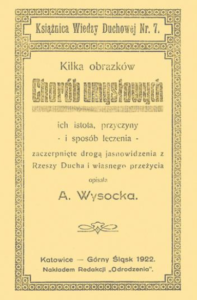 there in the early 1920s, she quickly became its leader and received the moniker, “The Clairvoyant of Wisła.” Her popularity declined, however, in the mid-1930s. In 1934, she and her husband became the editors of the magazine Hejnał” Miesięcznik wiedzy duchowej [The Bugle Call: Monthly of Spiritual Knowledge], in which Pilchowa published numerous articles. By then she had also authored several books.
there in the early 1920s, she quickly became its leader and received the moniker, “The Clairvoyant of Wisła.” Her popularity declined, however, in the mid-1930s. In 1934, she and her husband became the editors of the magazine Hejnał” Miesięcznik wiedzy duchowej [The Bugle Call: Monthly of Spiritual Knowledge], in which Pilchowa published numerous articles. By then she had also authored several books.
Pilchowa published her first pamphlets as Agnieszka Wysocka in 1922. One is titled Kilka obrazków chorób umysłowych. Ich istota, przyczyny i sposoby leczenie zaczerpnięte droga jasnowidzenia z Rzeszy Ducha i własnego przeżycia [A Few Pictures of Mental Diseases: Their Essence, Causes, and Methods of Treatment, Learned through Clairvoyance from the Realm of the Spirit and Own Experience] (Wysocka 1922a), [Image at right] and another sadly fits the prevailing antisemitic views, W niewoli 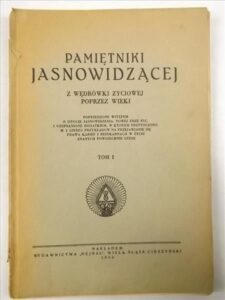 żydowskiej czyli wolno w Polsce jak to chce! Słowo Prawdy do Narodu [In Jewish Slavery or in Poland One Does as One Wants! Words of Truth to the Nation] (Wysocka 1922c). In 1930, she published Pamiętniki Jasnowidzącej z wędrówki życia poprzez wieki [The Clairvoyant Diaries from the Journey of Life through the Ages], a major work in which she described not only her clairvoyance and healing abilities, but also her alleged previous lives. [Image at right] Pilchowa’s other books are: Życie na ziemi i w zaświecie czyli wędrówka dusz [Life on Earth and in the Other World or Wandering Souls] (1926); Spojrzenie w przyszłość [A Look into the Future] (1933); and i Jasnowidzenie [The Clairvoyance] (1935). She also wrote occult novels that were very popular at the time: Zmora [Nightmare] (1932); [Image at right] and Umarli mówią [The Dead Speak] (1933). At the same time, Pilchowa was also active as a healer (Z życia n.d.).
żydowskiej czyli wolno w Polsce jak to chce! Słowo Prawdy do Narodu [In Jewish Slavery or in Poland One Does as One Wants! Words of Truth to the Nation] (Wysocka 1922c). In 1930, she published Pamiętniki Jasnowidzącej z wędrówki życia poprzez wieki [The Clairvoyant Diaries from the Journey of Life through the Ages], a major work in which she described not only her clairvoyance and healing abilities, but also her alleged previous lives. [Image at right] Pilchowa’s other books are: Życie na ziemi i w zaświecie czyli wędrówka dusz [Life on Earth and in the Other World or Wandering Souls] (1926); Spojrzenie w przyszłość [A Look into the Future] (1933); and i Jasnowidzenie [The Clairvoyance] (1935). She also wrote occult novels that were very popular at the time: Zmora [Nightmare] (1932); [Image at right] and Umarli mówią [The Dead Speak] (1933). At the same time, Pilchowa was also active as a healer (Z życia n.d.).
Pilchowa’s last prophecy was published in Hejnał in August 1939, in an article called “Czy będzie wojna?” [Will there 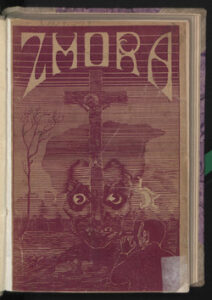 be a war?]. The author argued that the war would not break out, a prediction that turned out to be wrong. In September 1939, the start of World War II (1939–1945) and Poland’s coming under German occupation brought Pilchowa’s activities to an abrupt end.
be a war?]. The author argued that the war would not break out, a prediction that turned out to be wrong. In September 1939, the start of World War II (1939–1945) and Poland’s coming under German occupation brought Pilchowa’s activities to an abrupt end.
On November 27, 1943, Jan and Agnieszka Pilch were arrested by the Gestapo, the Nazi Secret State Police, likely as a result of the involvement of Pilchowa’s son, Stanisław Kurletto, in the Polish Home Army, the Polish resistance forces. The couple were kept in Cieszyn and then in Mysłowice until April 1944, when they were separated, and Pilchowa was taken to the Ravensbrück concentration camp for women in Germany. She died there on January 4, 1945, likely shot during the last execution of prisoners (Z życia n.d.). According to other sources, Pilchowa was already executed in 1944 (Dzwonek 1988: 26). Regardless of the date of her death, her body was never found.
DOCTRINES/TEACHINGS
Pilchowa wrote a great deal, but did not read much. When she expressed concerns about her limited access to books to her spiritual guardian, the latter responded that she did not have to read, as she could see everything “through the eyes of the spirit” (Pamiętniki Jasnowidzącej 1930). She claimed to draw all her knowledge from the astral world and from the images she saw recorded on “astral film.”
The basic assumptions of Pilchowa’s philosophy concern the spiritual (or astral) world, the real world of which the material world is an imperfect reflection. Spiritual reality is the matrix from which material reality emerged. In her theory of the spiritual origin of humanity, the human being arose as a luminous soul in the creative act of divine love. From our creator, we received not only a perfect spiritual body but also free will and the ability to create. Through unconstrained creativity humans created the material world, but with this creation moved away from God so much that we got trapped in matter, losing the memory of our origin and spiritual essence. In each person, only the “spark of God” survives, which causes people to long for their original spiritual condition (Pilchowa 1939). Pilchowa claimed that even after death the human being is not able to experience peace, because we are trapped in the cycle of rebirth. An individual’s karmic debt, and the depth of their sins, determines in what body and under which conditions one will be reborn in the next incarnation. Immediately after the death of the physical body, souls arrive at a place where they wait for their next incarnation. If the soul is spiritually developed, it has a better chance to return quickly (A. P. 1932).
According to Pilchowa’s visions, various astral creatures live on Earth. Ordinary people do not see them, which does not mean that these creatures do not influence their lives. The world revealed by Pilchowa’s visions is a terrifying place where astral strigas (Polish: strzyga, a kind of demon known from Slavic mythology), monsters, and vampires drain energy from humans, and evil spirits take possession of bodies whose souls wander off during sleep (Pamiętniki Jasnowidzącej 1930). The most terrible creatures in Pilchowa’s bestiary are the larvae: they arise as a result of a sexual act during which there is no conception. The larvae look like human masks with long abdomens. They remain with their creator, feeding on their energy, until the death of the host. They deprive people of the will to live and are a source of negative thoughts. The more larvae a person generates, the more difficult their life becomes (Pilchowa 1932).
The central figure in Pilchowa’s philosophy is Jesus Christ. Pilchowa considered herself a Christian, but she was against all forms of institutionalized religion. She particularly criticized the Roman Catholic Church, claiming that it distorted Jesus’ teachings. Pilchowa’s Christology was allegedly conveyed to her by her spiritual guardian, Mirjam, whom she referred to as simply her Guardian in her publications. Jesus (just like his mother Mary) was supposed to be only outwardly human, having no material body, but only an “etheric heavenly body” (Wysocka 1922b). God gave Jesus and Mary apparent material bodies upon their descent to Earth, so they would not be exposed to the attacks of evil spirits (Wysocka 1922b). Christ, through his passion and death, paid back the karmic debt weighing on humanity. Because a great number of sins were abolished due to Christ’s crucifixion, humanity could revive and regain spiritual consciousness (Pilchowa 1939).
Pilchowa denied the second coming of Christ. She claimed that parousia (Greek for “arrival,” “presence”) was the birth of Christ in every human being, a spiritual transformation leading to liberation from the cycle of rebirths and regaining the spiritual nature proper to humanity (Pilchowa 1939). In Pilchowa’s messianic vision, Poland (a country that experienced a history full of suffering) was the Christ of Nations that would lead other nations to salvation by preaching revealed truths, whose depository was to be Pilchowa herself.
RITUALS/PRACTICES
During her healing practices, Pilchowa reportedly diagnosed diseases, and found their causes, by shaking the hand of a patient. She claimed to feel the patient’s diseases in her own body and to heal with her “magnetism,” probably attempting to purify their aura with mesmeric passes (Z życia n.d.).
If a patient was not able to come to her personally, Pilchowa contacted them through a person close to them, or through letters, of which she received more than a dozen a day (Z życia n.d.). She refused to be paid for her work, and when patients brought money or food as a token of gratitude, she gave it to people in need (Pamiętniki Jasnowidzącej 1930).
Pilchowa claimed to have the ability to observe human auras, a gift that helped her in healing and clairvoyance. According to Pilchowa, people’s auras varied. Some were dark, dirty, and smelly, full of anger and lust. Such auras could penetrate and “infect” other people’s auras, and their owners were “unpleasant.” Other auras, however, radiated light and had a beneficial effect on others (Hadyna 1993).
In the interwar period, Pilchowa was known primarily as a clairvoyant. She was believed to see the past and the future through the images she saw on “astral film.” Pilchowa likened this film to a motion picture, but with more vivid, colorful scenes full of emotions. She believed that everything that happened on Earth was reflected in the astral world. Thoughts, deeds, words, and gestures were written in an astral library. With the right skills, one could read the library records that pertained to both the past and the future. Pilchowa herself claimed to have such skills (Hadyna 1993).
ORGANIZATIONAL LEADERSHIP
Pilchowa was the leader of the esoteric circle active in Wisła (Cieszyn Silesia, Poland) in the 1920s and 1930s. The core of this circle were Agnieszka Pilchowa, her husband Jan Pilch, and their children, Stanisław Pilch-Kurletto and Janina Pilch, who were all 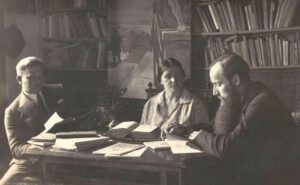 active members. Other prominent members included Andrzej Podżorski (1886–1971), Jan Hadyna (1899–1971), [Image at right] Maria Florkowa (1892–1972), Józef Chobot (1875–1942), and Kazimiera Chobotowa (1897–1976).
active members. Other prominent members included Andrzej Podżorski (1886–1971), Jan Hadyna (1899–1971), [Image at right] Maria Florkowa (1892–1972), Józef Chobot (1875–1942), and Kazimiera Chobotowa (1897–1976).
The Wisła esoteric circle ran an intensive publishing activity, printing periodicals, books by Polish authors, and translations of foreign books. The magazines they published were Odrodzenie [Revival] (1921–1929), Hejnał [Bugle Call] (1929–1939), and Wiedza Duchowa [Spiritual Knowledge] (1934), followed by Lotos [Lotus] (1935–1939). In 1921, the publishing house Książnica Wiedzy Duchowej [The Library of Spiritual Knowledge] was initiated by Józef Chobot. It operated until 1939, publishing almost forty books and brochures disseminated both in Poland and abroad. Another publishing house, called Hejnał, was run by Jan Hadyna and released mainly Pilchowa’s works. The Second World War ended the activities of those in the esoteric circle in Wisła. Pilchowa died in a concentration camp and, after the war, surviving members did not resume the circle’s activities.
ISSUES/CHALLENGES
The biggest challenge in studying Pilchowa’s work and biography is the lack of sources for her early biography. We must rely on sparse information from third parties, but above all on her autobiography. The difficult topics include the rape she experienced, her violent first marriage, and the impact of these traumatic events on her perception of sexuality, which she saw as a necessary evil burdened with spiritual consequences. From today’s perspective, the most controversial works are her antisemitic texts, which unfortunately were common in esoteric environments in Europe, and also corresponded with the nationalist moods of the late interwar period in Poland. The Clairvoyant from Wisła, as Agni was often called, was an extremely popular figure in Poland, not only as a writer, but also a healer. Her publications on the spiritual causes of diseases, especially mental diseases, as well as a strong emphasis on the spiritual consequences of sex, which led to such disorders, would have a completely different reception today. Some researchers even suggest that she suffered from psychological disorders, but this is not a new criticism for esotericists or religious movement leaders. One study from inside the esoteric community of Wisła points out that one should not get too attached to Agni’s visions and her prophecies, because they are extremely negative, full of cruelty, and one cannot focus only on bad things (cf. Hadyna 1993).
SIGNIFICANCE TO THE STUDY OF WOMEN IN RELIGION
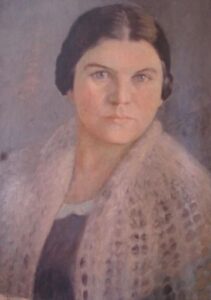
Agnieszka Pilchowa is an example of a woman religious leader who was very popular during her lifetime, and who was largely forgotten after her death. Research on the ideas she propagated gives a new look at the era in which she lived, revealing a very interesting religious pluralism of the time, with the exception of antisemitism. Pilchowa was undoubtedly one of the leaders of the esoteric circle in Wisła as a writer and healer. She was by far the most popular figure of this group, which consisted mostly of men. The study of Agni’s activities is also interesting because, although the group promoted syncretic beliefs and had liberal views in many respects, when it came to religious dogmas, it also presented very conservative views on corporeality, family, and marriage. Contrary to various esotericism-related women leaders propagating, among other things, women’s rights, Agni focused on very different angles of social issues, and was interested mostly in Esoteric Christianity.
IMAGES
Image #1: Agnieszka Pilchowa.
Image #2: Cover of Kilka obrazków chorób umysłowych. Ich istota, przyczyny i sposoby leczenie zaczerpnięte droga jasnowidzenia z Rzeszy Ducha i własnego przeżycia [A Few Pictures of Mental Diseases: Their Essence, Causes, and Methods of Treatment, Learned through Clairvoyance from the Realm of the Spirit and Own Experience].
Image #3: Cover of Pamiętniki Jasnowidzącej z wędrówki życiowej poprzez wieki [The Clairvoyant Memoirs: The Journey of Life Through the Ages].
Image #4: Cover of Zmora [Nightmare].
Image #5: Agnieszka Pilchowa with Jan Hadyna (on the right side of the photo) with issues of the journal Bejnał [Bugle Call], which they published. (The person on the left side of the photo is unidentified).
Image #6: K. Fechecki, Portrait of Agnieska Pilchowa, oil on canvas, around 1935.
REFERENCES
Agnieszka P. [Agnieszka Pilchowa]. 1932. Zmora. Powieść okultystyczna osnuta na tle prawdziwych przeżyć. Wisła: Wydawnictwo “Hejnał”.
Agnieszka P. [Agnieszka Pilchowa]. 1933. Spojrzenie w Przyszłość. Wisła: Wydawnictwo “Hejnał.”
Dulska, Małgorzata A., and Karolina M. Hess. 2019. “Nightmares, Lethargy, and Wandering in the Afterlife: Visions of the Mysteries of Life and Death in Agnieszka Pilchowa’s Novel Zmora.” Melancolia. Revista de Historia del Centro de Estudios sobre el Esoterismo Occidental de la UNASUR 4:57-82
Dzwonek, Józef. 1988. Wisła w jarzmie hitlerowskim 1939–1945. Wisła: KM ZBoWiD.
“‘Gdy czarny orzeł znak Krzyża splugawi….’ Sensacyjna przepowiednia z 1893 o przyszłych losach świata.” 1939. Ilustrowany Kuryer Codzienny 15, no. 86 (March 27): 6.
Hadyna, Stanisław. 1993. Przez okna czasu. Kraków: Instytut Ekologi i Zdrowia.
Magiera, Władysława. 2011. Cieszyński szlak kobiet 2. Czeski Cieszyn: Stowarzyszenie Klub Kobiet Kreatywnych w Cieszynie: Kongres Polaków w Republice Czeskiej Cieszyn.
Pamiętniki jasnowidzącej. Z wędrówki życia poprzez wieki. 1930. vol. 1. Wisła: Wydawnictwo „Hejnał”.
Pilchowa, Agnieszka. 1926. Życie na ziemi i w zaświecie czyli wędrówka dusz. Katowice: Nakładem Wydawnictwa Odrodzenie.
Pilchowa, Agnieszka. 1935. Jasnowidzenie. Wisła: Wydawnictwo “Hejnał”.
Pilchowa, Agni [Agnieszka]. 1939. “Czy będzie wojna?” Hejnał 11, no. 6-7 (August):537-48.
Wysocka, Agnieszka. 1922a. Kilka obrazków chorób umysłowych. Ich istota, przyczyny i sposoby leczenie zaczerpnięte droga jasnowidzenia z Rzeszy Ducha i własnego przeżycia [A Few Pictures of Mental Diseases: Their Essence, Causes, and Methods of Treatment, Learned through Clairvoyance from the Realm of the Spirit and Own Experience]. Katowice: Wydawnictwo “Odrodzenie”.
Wysocka, Agnieszka. 1922b. “Polska u progu Nowego Roku.” Odrodzenie 10: 7-12.
Wysocka, Agnieszka. 1922c. W niewoli żydowskiej czyli Wolno w Polsce jak kto chce! słowo prawdy do Narodu. Katowice: Odrodzenie.
Z życia jasnowidzącej Agnieszki Pilchowej. n.d. Typescript in the collection of Beskid Museum in Wisła.
SUPPLEMENTARY RESOURCES
Agni P. [Agnieszka Pilchowa]. 1929. “‘Jako w Niebie tak i na Ziemi.’ (Rewelacje otrzymane ze Sfer Ducha za pośrednictwem p. A. P).” Hejnał nad morzem życia, ze szczytów praw ducha i praw człowieka 5:129–31.
Agni P. [Agnieszka Pilchowa]. 1929. “I znów minęły święta Wielkiej Nocy… (Rewelacje otrzymane ze Sfer Ducha za pośrednictwem p. A. P.).” Hejnał nad morzem życia, ze szczytów praw ducha i praw człowieka 4:97–103.
Agni P. [Agnieszka Pilchowa]. 1929. “Jakie uczucia towarzyszą duchowi, odchodzącemu od ciała podczas konania i po tzw. śmierci (Rewelacja otrzymane ze sfer duchowych za pośrednictwem A.P.).” Hejnał nad morzem życia, ze szczytów praw ducha i praw człowieka 7:207.
Agni P. [Agnieszka Pilchowa]. 1929. “Jak tworzą się tzw. larwy i wampiry (Wyjątek z dzieła pt. “Zmora” w urywkach).” AgniHejnał nad morzem życia, ze szczytów praw ducha i praw człowieka 6: 166–71.Agni
Agni P. [Agnieszka Pilchowa]. 1929. “Święte Nieświętości. Głosy z Górnych Sfer Ducha (podane przez ks. Zbyszka za pośrednictwem A. P.).” Hejnał nad morzem życia, ze szczytów praw ducha i praw człowieka 7:199–203.
Agni P [Agnieszka Pilchowa]. 1937. “Dieta hamuje rozwój raka.” Hejnał. Miesięcznik Wiedzy Duchowej 4:178–80.
Agni P [Agnieszka Pilchowa]. 1937. “Gdzie są umarli?” Hejnał. Miesięcznik Wiedzy Duchowej 1:32–40.
Agni P [Agnieszka Pilchowa]. 1937. “Gdzie są umarli?” Hejnał. Miesięcznik Wiedzy Duchowej 4:155–57.
Agni P [Agnieszka Pilchowa]. 1937. “Gdzie są umarli?” Hejnał. Miesięcznik Wiedzy Duchowej 2:75–81.
Agni P [Agnieszka Pilchowa]. 1937. “Jak pracują umarli.” Hejnał. Miesięcznik Wiedzy Duchowej 12:550–55.
Agni P [Agnieszka Pilchowa]. 1937. “Na morzu życia.” Hejnał. Miesięcznik Wiedzy Duchowej 1:15–20.
Agni P [Agnieszka Pilchowa]. 1937. “Niewidzialne tło Zjazdu Poznańskiego.” Hejnał. Miesięcznik Wiedzy Duchowej 12: 54–58.
Agni P [Agnieszka Pilchowa]. 1937. “Panie, naucz nas modlić się.” Hejnał. Miesięcznik Wiedzy Duchowej 5:229.
Agni P [Agnieszka Pilchowa]. 1937. “Uzdrowienie ślepego dziecka (Urywek z pamiętnika.).” Hejnał. Miesięcznik Wiedzy Duchowej 3:100–08.
Agni P [Agnieszka Pilchowa]. 1937. “Wchodzimy w znak Wodnika.” Hejnał. Miesięcznik Wiedzy Duchowej 3:129–31.
Agni P [Agnieszka Pilchowa]. 1929. “‘Rosa Duszy’ (Rewelacje otrzymane przez Agni).” Hejnał nad morzem życia, ze szczytów praw ducha i praw człowieka 1:29–32.
Chobot, Józef. 1938. I. Mesjanizm polski: Istota – zasady rodowód i wskazania na przyszłość; II. Bronisław Trentowski, jego żywot – dzieła i nauki. Wisła: Książnica Wiedzy Duchowej.
Chobotowa, Kazimiera. 1935 “Gdy duch się budzi.” In Jasnowidzenie, by Agnieszka Pilchowa, 5-25. Wisła: Hejnał.
Czarnomski, Jan. 1935. “Karta z historji okultyzmu w Polsce.” Lotos 5: 151–53.
Czyż, Renata, and Zbigniew Pasek. 2008. Monografia Wisły. Kościoły i wspólnoty religijne 3, Wisła: Urząd Miasta, Galeria “Na Gojach.“
Golec, Józef, and Stefania Bojda. 1993. Słownik biograficzny ziemi cieszyńskiej. vol. 1. Cieszyn: published by authors.
Golec, Józef, and Stefania Bojda. 1995. Słownik biograficzny ziemi cieszyńskiej. Volume 2. Cieszyn: Published by authors.
Kłos, Jan. 1929. “Agni P. i jej zdolności jasnowidzenia.” Hejnał nad morzem życia, ze szczytów praw ducha i praw człowieka 3:71–74.
Kłos, Jan. 1929. “Agni P. i jej zdolności jasnowidzenia.” Hejnał nad morzem życia, ze szczytów praw ducha i praw człowieka 4:108–11.
Kłos, Jan. 1929. “Agni P. i jej zdolności jasnowidzenia.” Hejnał nad morzem życia, ze szczytów praw ducha i praw człowieka 5:137–42.
Kłos, Jan. 1929. “Agni P. i jej zdolności jasnowidzenia.” Hejnał nad morzem życia, ze szczytów praw ducha i praw człowieka 6:171–75.
Kłos, Jan. 1929. “Agni P. i jej zdolności jasnowidzenia.” Hejnał nad morzem życia, ze szczytów praw ducha i praw człowieka 7:203–07.
Kłos, Jan. 1929. “Agni P. i jej zdolności jasnowidzenia.” Hejnał nad morzem życia, ze szczytów praw ducha i praw człowieka 8:229.
Konarzewski, Dominik, and Michał Kawulok. 2008. Od wsi do uzdrowiska. Dziedzictwo architektoniczne Wisły. Wisła: Urząd Miasta, Galeria “Na Gojach.”
Padół, Roman. 1892. Filozofia religii polskiego modernizmu. Kraków: Wydawnictwo Literackie.
Pilchowa, Agni. [Agnieszka Pilchowa]. 1937. “Gdzie są umarli?” Hejnał. Miesięcznik Wiedzy Duchowej 8:355–63.
Pilchowa, Agni. [Agnieszka Pilchowa]. 1937. “Gdzie są umarli?” Hejnał. Miesięcznik Wiedzy Duchowej 9:413–19.
Pilchowa, Agni. [Agnieszka Pilchowa]. 1937. “Jam jest droga i żywot wieczny.” Hejnał. Miesięcznik Wiedzy Duchowej 10:436–40.
Pilchowa, Agni. [Agnieszka Pilchowa]. 1937. “Na błędnych szlakach twórczości.” Hejnał. Miesięcznik Wiedzy Duchowej 6:275-79.
Pilchowa, Agni. [Agnieszka Pilchowa]. 1937. “Urywek z Pamiętnika.” Hejnał. Miesięcznik Wiedzy Duchowej 8:314–17.
Wysocka Agnieszka (A.P.) [Agnieszka Pilchowa]. 1933. Umarli mówią. Powieść. Wisła: Cieszyn : P. Mitręga.
** The work was supported by the National Science Centre, Poland, under research project no DEC-2017/25/N/HS1/01317.
Publication Date:
8 September 2022
